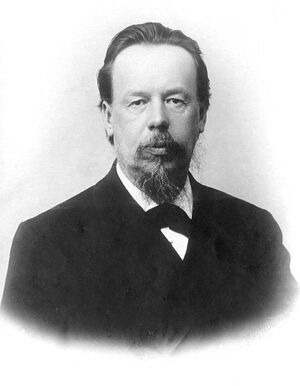Alexander Stepanovich Popov (nonfiction): Difference between revisions
(Created page with "thumb|Alexander Stepanovich Popov.'''Alexander Stepanovich Popov''' (sometimes spelled Popoff; Russian: Алекса́ндр Степ...") |
No edit summary |
||
| Line 5: | Line 5: | ||
On May 7, 1895 he presented a paper on a wireless lightning detector he had built that worked via using a coherer to detect radio noise from lightning strikes. This day is celebrated in the Russian Federation as Radio Day. In a March 24, 1896 demonstration he used radio waves to transmit a message between different campus buildings in St Petersburg. | On May 7, 1895 he presented a paper on a wireless lightning detector he had built that worked via using a coherer to detect radio noise from lightning strikes. This day is celebrated in the Russian Federation as Radio Day. In a March 24, 1896 demonstration he used radio waves to transmit a message between different campus buildings in St Petersburg. | ||
His work was based on the work of other physicists such as Oliver Lodge and contemporaneous with the work of radio pioneer Guglielmo Marconi. | His work was based on the work of other physicists such as [[Oliver Lodge (nonfiction)|Oliver Lodge]] and contemporaneous with the work of radio pioneer [[Guglielmo Marconi (nonfiction)|Guglielmo Marconi]]. | ||
== In the News == | == In the News == | ||
Revision as of 21:25, 6 May 2017
Alexander Stepanovich Popov (sometimes spelled Popoff; Russian: Алекса́ндр Степа́нович Попо́в; March 16 [O.S. March 4] 1859 – January 13 [O.S. December 31, 1905] 1906) was a Russian physicist who is acclaimed in his homeland and some eastern European countries as the inventor of radio.
Popov's work as a teacher at a Russian naval school led him to explore high frequency electrical phenomena.
On May 7, 1895 he presented a paper on a wireless lightning detector he had built that worked via using a coherer to detect radio noise from lightning strikes. This day is celebrated in the Russian Federation as Radio Day. In a March 24, 1896 demonstration he used radio waves to transmit a message between different campus buildings in St Petersburg.
His work was based on the work of other physicists such as Oliver Lodge and contemporaneous with the work of radio pioneer Guglielmo Marconi.
In the News
Fiction cross-reference
Nonfiction cross-reference
External links:
- Alexander Stepanovich Popov @ Wikipedia
